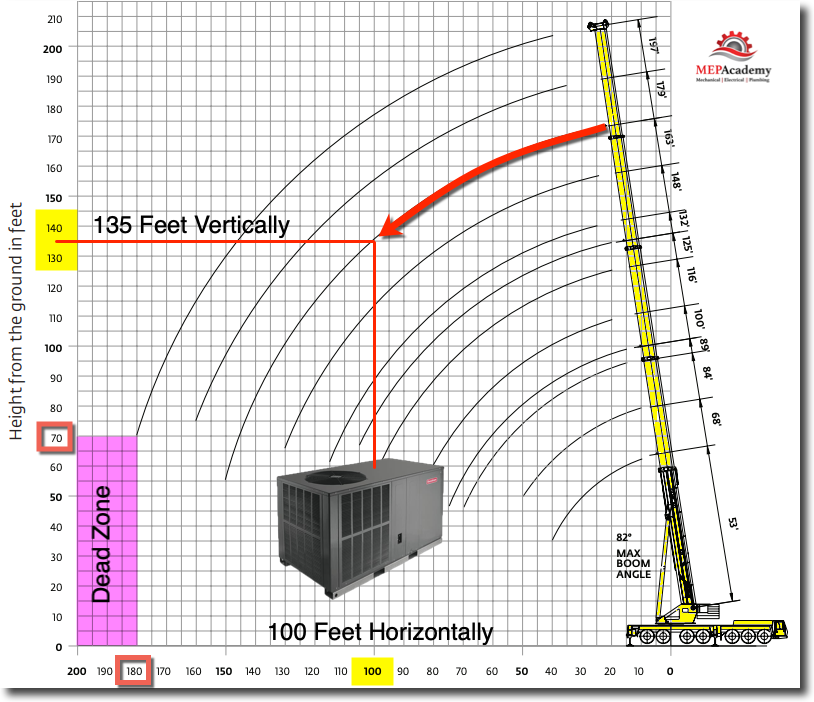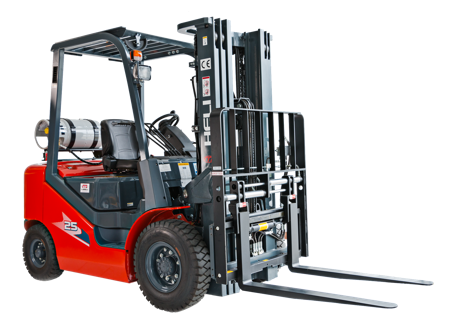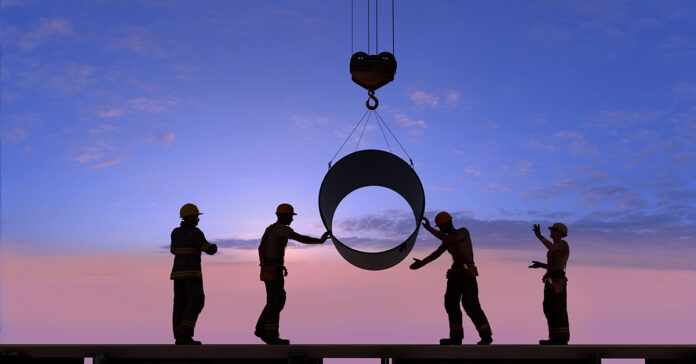Chapter #10 – Rental Equipment
Now that you have figured the labor to set each piece of equipment, you should have a good idea as to what rental equipment will be required for each task. Did you figure setting some of the equipment with a crane? Do you need a forklift to move materials around or remove a piece of equipment from a delivery truck, or to raise a heavy piece of equipment in the air or reach the second floor from the outside of the building in new construction? Will the works need a scissor lift to hang a section of piping or ductwork?
These are the questions you will need to ask yourself or others when analyzing the field labor required to rig and set the HVAC equipment. Using the proper tools makes for a more efficient installation and a safer project. The total cost for equipment rentals appears under other cost on the estimate summary sheet of your spreadsheet.
You must have a good idea how long you will need the rental piece of equipment, as rental rates are cheaper the longer you rent them, but you don’t won’t to rent them longer then you need them ,as this would make your bid less competitive.
Helicopters
Sometimes the only method of safely getting equipment to its point of use is by helicopter. Helicopters are useful in placing equipment that sits far from the side of the building, or when there are multiple buildings. These are some of the cases where a helicopter will be more feasible than a crane. Call an get a quote for any job that you are bidding that may require a helicopter to see how it compares to the use of a crane.
In the video below you’ll see Air Conditioning units being helicoptered onto AC Adapter curbs. Adapter curbs are used to match up the existing curbs supply air and return air configuration with the new A/C units supply & return air configuration. This video is for just two air conditioners, but we have rigged more than 100 air conditioners in a day using a helicopter.
For larger HVAC units you would need to a much larger helicopter such as that provided by Erickson Crane. For Large and heavy HVAC units you would need the S-64 Aircrane from Erickson which has the capacity to lift up to 25,000 pounds. (See the video below for the S-64 Aircrane) They have smaller helicopter that will do up to 7,000 pounds.
Cranes
Cranes are good for a wide range of equipment and purposes. If you have something located on a roof that is too heavy to carry safely up the stairway you might need a crane. Anything from a small sign crane to a large built-up crane can be secured from one of many crane rental companies. If conditions are such that a crane cannot reach the roof or isn’t feasible you may need to call a helicopter operator who specializes in HVAC equipment rigs. Sometimes the use of a helicopter makes sense over a crane, because of site logistic, such as having many buildings spread out over a campus, which would require a crane to move and setup multiple times.
Watch this video of a 550 Ton Hydraulic Crane rigging large Air Conditioners off and onto this building. It takes considerable effort to put this crane together to handle the weight of these air conditioners and for the crane to reach the units. Of course not all cranes have to be built up like this one, but this shows you the cost involved when rigging heavy HVAC equipment that is located far from the perimeter of the building.
Prices and regulatory requirements vary from location to location, so call your crane or helicopter company with the address of the building and the size and weight of the heaviest piece of equipment. Also, you will need to let them know how many equipment picks you have going up and down, the location of the equipment on the building. The distance from where the crane can set up to the location where the equipment will be set and the height of the building affects the size of the crane and the cost.
Below is a quick video of the crane rig of several rooftop air-cooled chillers. The workers first grind off the welds that are holding the existing air-cooled chillers to the support steel.
Crane Charts
The size of the crane required is based on the weight of the HVAC equipment and the height (Vertical distance) and (horizontal distance) to where the unit will sit on the building. As shown in the Crane Chart below for a 550-Ton crane, there is a point at which the crane can’t reach (shown in pink) without adding additional jibs or extending arms if available.
The crane rental companies use software that determines the required crane size based on your rigging requirements. The crane charts provide a quick visual representation of the various limitations based on vertical and horizontal distances. Check Bragg Cranes website for additional information on cranes and their rigging capacities.

Scissor Lifts
Scissor lifts are useful when the working height becomes unsafe for ladders. In construction safety should always be the priority, so you want to make sure your workers are provided with adequate tools to do their jobs. Definitely anything heavy and awkward that is to be installed over 15 feet in height will need a scissor lift or some other raised platform to work from.
You will need to determine how many hours you have in the area with the high working environment, and how many workers will be doing that task, so you can determine how many days, weeks or months you will need the rental equipment. This is one of the reasons we breakdown a takeoff into different areas and task, so that we can analyze labor and rental equipment requirements.
Watch the video below to see how they operate.
Forklifts
Equipment being delivered to the jobsite that will not be rigged with a crane the day it arrives will need to be taken off the truck and stored until rig day. Heavy equipment will require something like a forklift to remove it from the truck and move it around the project site for temporary storage. Forklifts are good for moving heavy pieces of equipment safely around the jobsite, or for loading pallets of material from a truck to a laydown area. They are also good for loading equipment or material onto the second floor if within reach from ground level.

Boom Lifts
These are used where a scissor lift won’t work. Scissor lifts are good for going up and down, but a boom lift does that and more. The boom lift can go up and pivot over objects to reach areas that a scissor lift can’t watch the enclosed video to see the versatility of a boom lift.
Articulated Booms provide additional versatility (watch video below). Check with your rental equipment provider to see what the equipment capabilities are in your area. This particular articulating boom lift is in Australia, but similar boom lifts are available worldwide. The video below is a little dramatic, but hold out to see just how well this equipment works.
Backhoes / Excavators
If you will be digging a ditch for underground pipes or ducts, then a backhoe might be needed. If you subcontract all of your excavation and backfill you won’t need to worry about this rental equipment. Make sure to include the hourly cost of the backhoe operator if you don’t have someone capable of doing it.

Welders
If you plan on doing any pipe, duct or support steel welding, make sure to include the cost for welders. Gas or electric welders can be rented for the day, week or month.
Air Compressors
Some tools require pressurized air to make them operate including some jack hammers.
Groover’s
If you will be fabricating grooved pipe onsite for grooved type connections then having this tool at the site will save time and money.
Storage Containers
Each project has different requirements, but most new construction projects will need a storage bin to lock up your materials and tools, otherwise they could be stolen, or you would need to handle them every time you arrived and left the project site.
Miscellaneous Equipment
This piece of rental equipment helps save on the cost of using a larger crane to reach far from the perimeter. By using a smaller crane that to rig the HVAC units onto the perimeter of the roof at the point closest to the edge of the roof, then using this piece of rental equipment to roll the HVAC units into place, will save money by not having to use a larger carne.
As an estimator you should search for better ways to do things that will make you more competitive, this is just one way.
Contractor Owned Rental Equipment
If your company owns a piece of equipment you could normally rent it, then charging it to the project at a reasonable rental rate is one way to recoup its cost.
You might be thinking, why don’t I leave out the cost of the company owned rental equipment and make our bid lower. Every piece of company owned equipment has value that is depreciating as it gets older, and it cost money to operate and maintain. So if you don’t charge for the equipment you would theoretically be losing money. The cost to operate that piece of equipment has to come from somewhere and rightly it should come from the job that is benefiting from its use. Gas, oil, tires, parts and maintenance will be expended in the use of that equipment. Make it a happen to charge for company owned rental equipment unless its cost recovery is included in your labor burden rates or some other recovery line item.
There are many more pieces of rental equipment that you will encounter, but the list below will get you started. List all those pieces of rental equipment that you normally rent on your rental form in your estimating spreadsheet along with their rental rates for either daily, weekly or monthly.
You should setup your rental sheet on your estimating spreadsheet with the rental equipment that you rent most often. This will save you time from having to re-enter the data over again. List the rental equipment and the rate you are charged for the duration that you expect to use for this project. If you have 240 hours of work in a high bay area that requires a scissor lift and a two person crew, that is equivalent to three weeks of rental. In that case I would carry a months’ worth of rental for a scissor lift.
If you have many pieces of equipment coming from various vendors, all to be rigged onto the roof, then you might want to receive all the equipment into your warehouse or pay the crane company extra to store the equipment until rig day.
Sources of Rental Rates
There are numerous sources for equipment rental rates.
Local Rental Company
The best source of course is your local equipment rental company, the one you most often and trust. If the project is far from your normal rental company, then you will want to get prices from rental companies in the area where the project is being built or renovated.
MCA (Mechanical Contractors Association)
MCA publishes a book of rental rates for various pieces of equipment and tools. This is a good source if you own your own equipment and are trying to negotiate a fair rental rate with an owner or GC (General Contractor). Remember just because you own a piece of equipment, doesn’t mean you can’t charge for it. The cost should be included in your change-orders if the contract allows.
Army Corp of Engineers
The Army Corp of Engineers publishes rates for various rental equipment.
Blue Book Rental Rates
Sheet Metal Field Installation Course
- Chapter #1- Rectangular Duct and Fittings
- Chapter #2 – Round Ductwork and Fittings
- Chapter #3 – Sheet Metal Duct Hangers
- Chapter #4 – Sheet Metal Field Labor Productivity
- Chapter #5 – Labor Crew Sizes
- Chapter #6 – Sheet Metal Duct Sealer
- Chapter #7 – Sheet Metal Details and Specialties
- Chapter #8 – Grease Exhaust
- Chapter #9 – Air Distribution
- Chapter #10 – Rental Equipment
- Chapter #11 – Conditions Affecting Field Labor
- Chapter #12 – HVAC Equipment Labor
